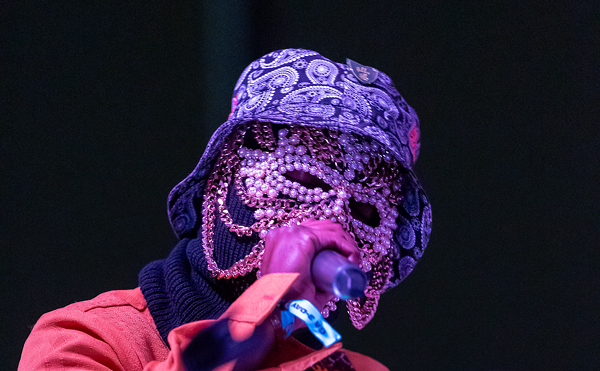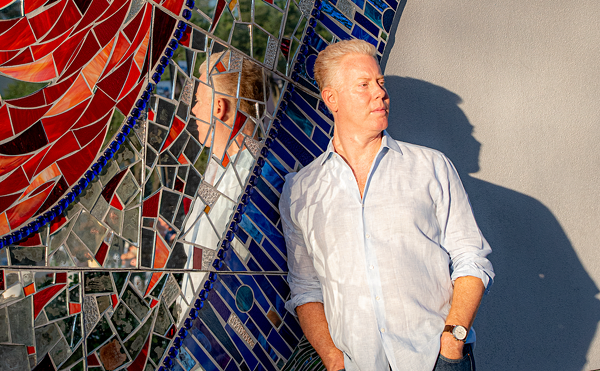Mandy Akins Aldrige has a dual identity.
It’s not a secret identity; her friends all know about it and the people she meets while doing it already know about it because they’re doing it, too. Even her co-workers know about it, and the knowledge doesn’t faze them one bit.
“Guys I work with all know what I do with my spare time and they’re like, ‘Yeah, you’re weird.’ That’s it,” Aldrige said. She sits on her couch, facing a collection of fabric and materials on her coffee table. After a few minutes she picks up a tiny top hat and begins applying fabric to it. “They don’t think I’m deviant.”
By day she works as a journeyman electrician in the Tampa Bay area. On nights and weekends, however, she becomes Supergirl. Or maybe Emma Frost. She could have been Rogue if she wanted, but she’s a natural blonde and she doesn’t like how her hair looks when she dyes it brown.
Aldridge, like millions of others around the world, creates costumes based on characters in comics and movies. She tours conventions throughout the U.S. showcasing her talents by dressing up as any of the several characters she has made outfits for.
A quick tour of her online social pages shows off her work. In one photo she’s sporting a Michael Turner-inspired classic red and blue Supergirl outfit at a convention. In another she has on the same costume in a more menacing black and silver pattern. There are a few photos of her with friends dressed in apparel from Kandy Girl, a clothing line that Aldridge and friend Kacy Burchfield co-founded a few years ago. All of the girls have Rainbow Brite-inspired outfits on and hair falls that match their costume colors.
“I started costuming in 2002. I had been sewing since I was 9. My mom taught me, and the first thing I made was a really ugly African print dress. I don’t know why I decided to do that, but it’s pretty hideous.” She reaches over the table to select some crinoline for the hat in her hands. “The very first costume I did was Emma Frost from X-Men. White cape, white bustier and thigh-high calfskin stilettos that were horrendously uncomfortable.”
But that’s part of the draw.
“It’s kind of fun to step outside of yourself for that period of time, but we’re kind of camera whores, too,” Aldridge said. “There are certain spandex things I won’t try, for example. I’m good but not necessarily that good.”
Costume creation and modeling, now collectively known as cosplay thanks to the mass influx of anime into western culture, has long been a fixture among fans of comics and science fiction. For general purposes, the term cosplay gets used primarily in Western civilization as a moniker for those focusing on Japanese anime and manga material. Look up the word "cosplay" online and most likely you’ll get images of costumers dressed up as shinobi from the insanely popular anime and manga series Naruto rather than a group representing the proud 501st Legion of Imperial Storm troopers.
While seen by outsiders as strictly the province of strange people who think Halloween should be a year-long activity, the term cosplay has managed to lump everyone wearing a costume into one group. The term can now be used to describe everyone from a tween dressed as Princess Zelda to a 60-year-old with dip in his lip and a Confederate officer’s uniform on his back as he marches to reenactment glory at Gettysburg. It’s the same way that the term "sports fan" can apply to both the casual team supporter and the maniac wearing body paint and colored afro wig to the home games, and Aldridge has to work hard to get clear of the blanket definition.
WANNA GO FOR A SPIN?
When Spider-Man 3 was released in 2007, the Marvel Appearance Company helped drum up business for the movie by deploying their Marvel Superhero corps around the country, which made appearances everywhere including shopping malls, movie theaters and various Wal-Marts around the country.
This led my friend Chris, another costume enthusiast and already a regular with the Marvel Appearance Company, to contact me and ask if I would be interested in working with Marvel.
He explained the actors' jobs as being pretty straightforward: dress up as a Marvel superhero, sign autographs, shake hands and take photos with fans for a few hours. In this regard it’s really no different than dressing up as a clown for a car sale or Mickey Mouse at Disney World, only with cooler costumes and potentially fewer kicks to the crotch.
I’m not sure when the concept of business owners getting someone to dress up in a costume to excite people over products ever came into being. Modern history might dictate that it came about sometime in the late 20th century when advertisers began using the music and imagery of the 1960s to sell cars and bath soap. But this wouldn’t be shilling for a car lot; I was being given a shot at finding out what it means to wear the mask.
“It’s fun,” he told me. “When I meet kids and they say ‘do a flip,’ I can. It makes them happy.”
So I said yes. The Marvel Appearance Company asked for headshots, body shots and sent me an orientation video about what not to do while in costume. After this, the representative, a very polite and professional lady, stated they would be in touch with any jobs available in my area. We exchanged a few pleasantries before hanging up.
Only later would it occur to me that, while I had reached the point in my professional life where work uniforms no longer applied, I had voluntarily agreed to wear one anyway because it would look really cool.
COMPLICATIONS
Regardless of what genre the costumer wishes to be a part of, the primary roadblocks for creating a good costume include the time, money and ability to create a good costume. A costumer can, for example, aspire to recreate the costume of the Satanic-looking Lord of Darkness from the film Legend and end up with a half-baked Hellboy costume with the tights sagging off the butt, and nobody wants to be That Guy at a convention.
“You can spend a thousand dollars on material for a single costume alone,” Aldridge said. “There are guys out there with leather Green Lantern costumes.”
Costume makers have to pay for the materials out of pocket, and unless they have a monetary agreement with the companies that hold the trademark rights for the characters, they do not get paid for their appearances. Some enthusiasts do this by themselves, while others meet at conventions and form social clubs that share information and costuming tips, using comics and movies as reference material. And some do it for charity; the Heroes Alliance of Tampa has a long history of appearing at food drives and children’s hospitals, and while the Wolf Pack Elite enjoys a good reputation for hosting fantastic convention parties, they also visit the Make A Wish Foundation on a regular basis.
Still, the reactions people give when they see the finished product seems to be enough of a reward for them. At a movie theater, costumer T.J. McDonnell wears a Spider-Man outfit and poses with theater patrons as they wait in line. One boy runs over for a photo, smiles while the camera flashes and runs back to his parents. As they walk into the theater, the boy turns around and waves. “Goodbye, Spider-Man!”
Beneath his mask, McDonnell smiles. “That’s where it’s at. There’s a great sense of joy doing something simply for the sake of it.”
Another curious fan walks over. “You gonna fly or something, man?” McDonnell doesn’t miss a beat. “No, that’s the other guy in blue and red.”
Really good costumes have their own dangers, too. Unruly fans like to heckle and be rude, while others get so excited they have been known to tackle their heroes for a photo opportunity. Glomping, in which a hug is delivered from one person to another via occasionally violent means including tackling, pouncing and occasionally clotheslining, has become a staple and occasional hazard of costuming. Every convention, someone makes a really great costume for a really popular character, and every time that person gets tackled on the blind side by rabid fans demanding pictures.
But costumers might also be striving for the impossible. In his essay “Secret Skin,” author Michael Chabon charted out an analysis of the superhero costume based on his personal experiences of attending numerous sci-fi conventions and his own boyhood attempts at becoming a superhero. While he marveled at many of the costumes he had seen in his travels, Chabon, whose novel The Amazing Adventures of Kavalier and Clay deals heavily with the superhero mythos, suggests that the attempt to render a superhero as a living being would ultimately only prove futile.
“Without exception,” Chabon writes in his essay, “even the most splendid of these getups is at best a disappointment… The superhero costume as drawn disdains the customary relationship in the fashion world between sketch and garment. It makes no suggestions. It has no agenda. Above all, it is not waiting to find fulfillment as cloth draped on a body.”
To be clear here, Chabon is not attacking the people who create and wear these costumes, but rather the sheer impossibility of creating a three-dimensional rendering of a subject meant only to exist on paper. On the comic page, the superhero costume is a sublimely perfect creation; the armor has no chinks or bare spots, spandex bodysuits have no seams and don’t sag after being stretched out, the capes don’t expand to float in the wind and then contract for close-quarters combat. The loss of reality applies both to the superpowers and to the cloth draped over the superhero. In every sense, nothing on the pages can be perfectly recreated in the real world.
LET’S PUT IT ON
The costumes the Marvel Appearance company supplies range from skintight to bulky, or occasionally both. One costume, the Iron Man, came to me by FedEx in a traveling case on wheels, the same kind of case vendors use to transport their trade show booths. It was bulky, too; when FedEx dropped the package off at our apartment complex, the office manager called my wife and told her the coffin we had ordered had arrived.
Iron Man’s alter ego, billionaire inventor/industrialist Tony Stark, is the kind of public persona dreamt of by any male who ever harbored visions of being The Man: he’s a rich, incredibly smart, hard-drinking womanizer who works hard and plays hard. I, however, am merely a journalist with a penchant for martial arts and Goldfish crackers. I am not Tony Stark; I just have his armor.
Iron Man’s armor comes as 17 different pieces including the helmet and a pair of red shoes two sizes too big for my feet. Every piece comes encased in bubble wrap, with extra sheets underneath the armor to repack everything for shipment back. Everything to make a good Iron Man is here, from the repulser blast gauntlets to the arc reactor. Ever hopeful, I double-check the coffin case just to see if Marvel sent me a few complimentary stacks of money (for props) and find none.
Disappointed but not defeated, I unload the armor and consider its assembly. Assembling a costume with multiple pieces can be like putting together an entertainment center; there are many pieces of differing size and the instructions you get are always the ones printed in Mandarin. It took half an hour to figure out how to put the costume on: first the flight suit made of spandex, then the plastic leggings and shoes followed by the arm pieces. The chest chassis clicked on easily enough, but the shoulder joints had to be bolted on; once those were in place, I couldn’t lift my arms higher than shoulder level.
While I was trying on the flight suit, my wife spotted the Iron Man helmet sitting in the box right by the metal underwear. She picked it up and, after grinning at me for a second, pulled it over her head. It was large and made her look like she had been suffering from an affliction that made her head swell up like a helium balloon. She sat down on the couch and started flashing gang signs at me with twisted fingers. “Do I look badass?” she asked. “You look like a Mardi Gras head,” I replied. A pillow flew by my head, offering proof of the limited visual powers of the helmet.
Pulling the helmet over your head gives you a feeling of equal parts awe and self-admonishment. It was on and it felt good, yes, but I began wondering about my choice of outfit, company-mandated though it may be. As it slid over my head I experienced a quick but severe attack of claustrophobia. The helmet’s visor only lets the wearer see at eye level and most of the air exhaled stays in the faceplate, heightening the sensation of enclosure.
Breathing heavier than I should have, I reached up to take the helmet off and discovered I couldn’t raise my elbows higher than my shoulders without choking myself on the chest piece. I started to panic and the wife moved in to assist, but when she tried to take the helmet off she caught the lower jaw part of the mask on my chin and I squirmed in protest, thrashing my arms helplessly. She backed off and tried again, this time hitting me between my teeth and then again on my nose. I told her to just rotate the faceplate up first, and then I was exposed to the fresh air of our apartment. I took several minutes to catch my breath. “Are you okay?” she said. “I think so,” I said, breathing steadily now. “How does it look?”
“Really bulky.”
How the hell did Robert Downey Jr. survive this? “It’s not too bad, actually. I just can’t move my head much.”
“Well, you’re not going to be flying around in that thing, right?”
“No, of course not.”
“Then you should be okay.”
Okay, and apparently very popular. At the show I was appearing at, people had already lined up to meet Iron Man even before I arrived. The first time I stepped out of the green room in costume with my convention worker chaperone I got calls from all sides.
“Hey, Iron Man!” one kid (I could barely see anything, so I’m assuming it was a kid) called out repeatedly. And then other people began looking away from the new model cars on display and began speed-walking toward me, camera phones already out.
It takes me seven minutes to walk the 30 feet from the green room to the escalator, being stopped every five inches for another photo op. Upstairs, a line stretches out from my work table back to the stairs. Kids in Iron Man t-shirts look excited, scared, some even exultant. A few non-believers sulk at being forced into line for a picture with a fake Iron Man, and only a few demanded that I start flying around the room to prove myself. “I can’t right now,” I told them, my voice muffled through the helmet’s mouthpiece. “My arc reactor is too low on power.”
“Then shoot a laser out of your hand!”
I tap the armor’s chest piece, again indicating said arc reactor. “No can do. How about a photo?”
The kid grudgingly elects to receive, but I wonder how much of his childhood I just shattered by not sticking a roman candle in my arm piece and pretending to shoot the flares off my gauntlets just to keep him happy.
GO BIG OR GO HOME
Let us pause to consider another challenge of costuming: fitting the body type. There has long been an argument, both in the costuming community and the rest of the free world, about the appropriateness of certain costumes on certain body types. Partly it’s an argument about public service; one can never really un-see something like a 300-lb. convention attendee with back hair dressed as Dr. Frank-N-Furter from The Rocky Horror Picture Show, but the argument also focuses on the accuracy of having someone that can never physically resemble Cloud Strife dress up like him for a weekend.
“It’s very difficult to do some of the costumes,” Aldridge said. “You can’t have a 200 lb. guy playing Plastic Man. Spandex is a privilege, not a right.”
Ah, spandex, a tried and true cornerstone of costuming that can either titillate or terrify a costumer’s fellow convention-goers. I had seen this many times myself, often with comical and disastrous results. Many people would attempt costumes that failed to suit their body type or physique; for every perfect Full Metal Alchemist character there are usually three that are too fat, too skinny or too hunched to fit the character. Results I have experienced first-hand have included bearded Batmen, large Sailor Moon scouts, an Ash with no chainsaw and one Jedi knight wearing a bathrobe, tie-dyed shirt and Jackie Stallone headband and wielding a karaoke mic for a lightsaber hilt.
“A lot of the female characters are very difficult to do, because they all have huge tits and tiny waists, but spandex has a multitude of sins,” Aldridge said. For proof, just google ‘Power Girl Cosplay.’
In this sense, superheroes have it much easier. Even with the impossibly sculpted bodies found on the comics page, most modern takes on superhero costumes allow for more leniency in body type. Consider the Batman costume sported by Christian Bale, more body armor than spandex and doing nothing to accentuate the actor’s impressive physique beyond looking like he could shake off an artillery round to the chest. By contrast, anime fans have the task of recreating characters that are impossibly slim, big-eyed and sporting the kind of androgynous beauty celebrated in a fashion catalog. It can be a daunting, scary mountain of a task, with large cliffs, long drops and sharp crevices for an audience made up primarily of Caucasian teens.
But Aldridge also feels pride for those who ignore the unwritten rules.
“I went to a panel with a girl I knew and she said, ‘If you don’t look the part you shouldn’t wear the costume.’ Screw that nonsense. If you’re comfortable in a costume and you think you look good, wear it. People will make fun of you no matter what because you’re walking around in spandex.”
None of these unwritten rules really matter to a costumer, of course. If a 300-lb. woman wants to dress up as a Sailor Scout, she's going to do it and screw anyone who tells her otherwise. It’s her fantasy and she's going to live it.
FRIENDLY NEIGHBORHOOD
If Iron Man was a small challenge, Spider-Man was a joy.
Everybody loves Spider-Man, recent questionable films notwithstanding. While Iron Man’s Tony Stark is the jet-setting Howard Hughes-like playboy, Peter Parker represents the everyman of the Marvel Comics universe. Despite the 40-plus years’ worth of efforts from many talented writers who would have you believe otherwise, the neurotic superhero is a mega star whose status gets betrayed by the numerous paradoxes in his fictional existence. He’s portrayed as perpetually broke but somehow manages to pay for a Manhattan apartment on a freelance photographer’s salary. He’s a science geek and has the body of an Olympic gymnast. A one-time favorite target for bullies, he was married to a red-headed supermodel for 20-some odd years and gets hit on by a thief wearing a skintight cat outfit. This guy is a rock star pretending to be a schlub.
In contrast to the plastic iron maiden that was the Iron Man, the Spider-Man costume arrives in a mailing bag along with the usual notice warning me not to try and keep the costume once the gig ends. I arrived at my assigned site and was shown into the manager’s office to change.
Spider-Man’s costume is a spandex one-piece with plastic padding on the feet soles, meshed eyespots and a zipper across the shoulders. You have to work your way into it from the feet up, a slow, careful process that involves a good deal of material stretching. It’s like pulling on a giant blue and red condom decorated in spider-webs.
There weren’t too many people in the store when the photographer that would be paired with me for the afternoon led me to a spot by the toys and garden, where a backdrop of a city skyline had been set up for photos. For a few minutes I did nothing but crouch on the ground, trying my best to look like a radioactive arachnid-powered superhero. After a few minutes, my keen spider-senses (my ears) detected a mother and child behind the backdrop examining the clearance items. I stuck my head out around the corner and addressed them in my best superhero voice. “Everything all right over there?" She turned at the sound and frowned for a moment. “Down here, ma’am,” I said helpfully from the floor.
THE TRUTH
Costumes are meant to serve as a type of conduit for the character when you pull the tights on and slide a mask down your face. Chabon knew that, too. “One knew, of course, that it was not the red cape any more than it was the boots, the tights, the trunks…yet you had only to tie a towel around your shoulders to feel the strange vibratory pulse of flight,” he wrote. “It was not about escape… it was about transformation.”
Trying to display a character for whom everyone has a mental image is going to be a failure – too many people have too many differing ideas on how the character should look – but that doesn’t stop the sense of empowerment that comes with pulling the spandex mask down your face and walking into a crowded room.
The lady in Wal-Mart followed my voice and looked down at me. When she realized who I was, her face lit up and she called for her son. The next four hours were a happy blur of handshakes, high-fives, autographs and mugging for the camera: the Instant Superhero Celebrity, just add an actor and a spandex suit.
I was told later that many shoppers were coming to the store specifically to get their picture taken with Spider-Man. That struck me as truly strange. Most of them had to know they were queuing for a picture with a guy in spandex who they knew could not REALLY be Spider-Man, right? But it didn’t matter. Parents pushed frightened kids at me, a few teenage girls yelled that I was cute and one lady with a “World’s Greatest Grandma” shirt kept asking me to flex a bicep. They wanted a Spider-Man and they got what they came for.
I began to wonder if maybe they knew something I didn’t. I found myself more than once looking at the walls and ceilings and wondering if my gloves and boots had any adhesive on them for demonstrative wall-crawling purposes. I checked my wrists for web shooters before remembering the costume didn’t have any. If someone had dared me to go outside and bench press a Volkswagen Beetle, I would have taken them up on it while chuckling “sucker” under my breath. The joke would be on them.
As long as I have the mask on, I am powerful.
















